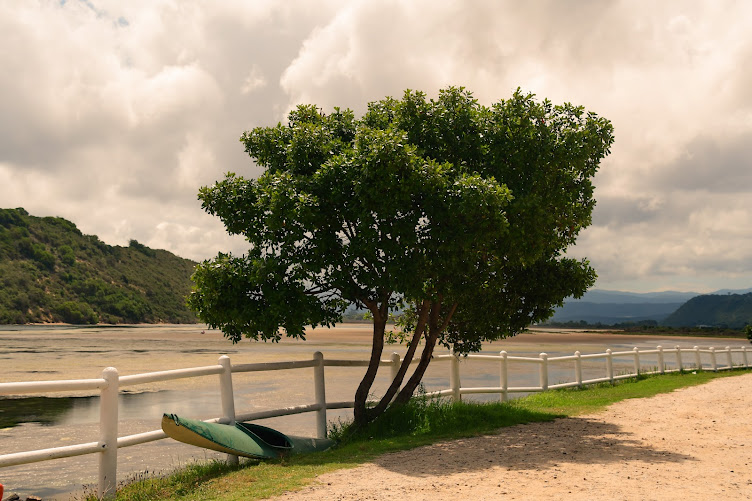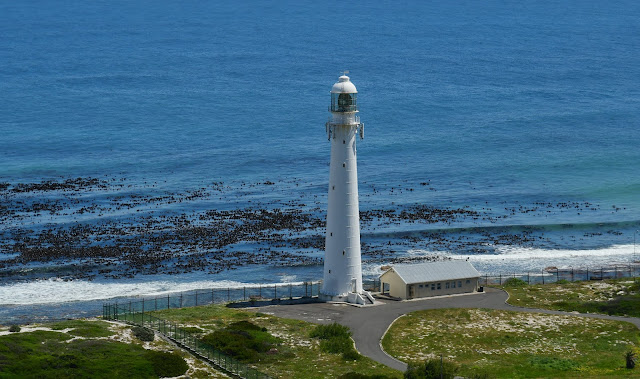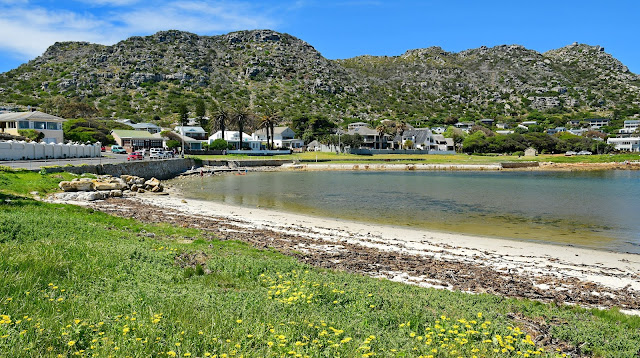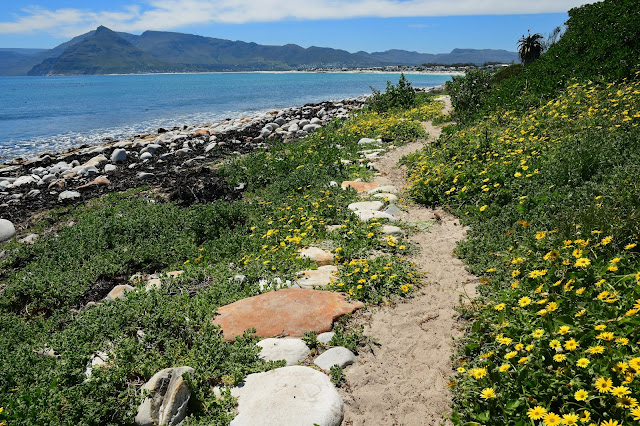Fishing in the Cape Point Reserve is a favourite pastime with local Capetonions, no matter what the weather!
Whilst it is a "must" to get to the top of this iconic lighthouse, do allow time to enjoy the entire park.
If the Flying Dutchman Funicular is not operating, then it is quite a climb. But very well worth it.
The views are spectacular with the cliffs at the southern point towering 200 metres above the sea. Look out for all 3 - Cape of Good Hope, Cape Point and Cape Maclear. It was fascinating to watch the birds on the cliffs in the photo below - for more info on the sea birds of Cape Point, see the very interesting article below:
The "new" lighthouse stands proud on Dias Point (see photo above) and is one of the most powerful on the South African coast. With a range of approx. 60 kms, all ships should be safe rounding the Cape.
Buffels Bay boasts a stunning beach and also has a tidal pool plus braai places
With ostriches roaming close to the beach at times or baboons fighting over shellfish, there is always something for both adults and children to enjoy. Please keep a safe distance from baboons as they are wild animals and are attracted by food. It was wonderful watching them eating the mussels and very obviously enjoying every morsel!
For hikers Cape Point is a dream - there are many hikes to choose from, from 1.5 hr round trips to overnight hikes.
The Lighthouse Keeper’s Trail is often overlooked by visitors eager to pay a visit to the iconic old lighthouse atop Cape Point, but this short trail that runs below the well-known landmark should not be missed. The trail begins just behind the upper funicular station, and a narrow but well-established path will lead you along a sheer cliff-face towards the lesser-known new lighthouse. It offers a fascinating perspective of the old Cape Point lighthouse which towers many metres above, and it walks you through historical bunkers and beautiful fynbos until the path runs out, at what certainly feels like the very tip of Africa.
Departs: Behind upper funicular station. Park at the Cape Point main parking area and walk to the station or save energy and take the funicular.
Distance: +-2km, one hour return
Difficulty: Easy
 |
| Lighthouse Keepers Trail Cape Point |
Cape of Good Hope Trail
The Cape of Good Hope trail takes you along a well-maintained and marked boardwalk towards the famous Cape of Good Hope sign, located on the rocky shoreline far below. The trail is popular for its accessibility, and for the unsurpassed views over the pristine Diaz Beach and rugged western shoreline. Make your way all the way to the very end of the trail, and you’ll have reached the most southern point of the Cape Peninsula – a perfect photo opportunity to prove that you’ve visited the most South Western corner of Africa.
Departs: Cape Point main parking area. Follow signs towards Cape of Good Hope.
Distance: +-3.5km, 2-3 hours return
Difficulty: Easy
 |
| Cape of Good Hope TRail |
Antoniesgat Trail
Buffels Bay Beach is a gem hidden from the main tour groups, and the Antoniesgat Trail that departs from nearby offers beautiful views, a moderate level of difficulty, and the opportunity to cool off in the tidal pools, or enjoy a braai at the well-maintained facilities, at the end of the walk. The walk takes you close to the action where powerful waves pound the peninsula, and there are a number of caves and tunnels to explore en-route. The views over the bay, towards the mountains, and of course up towards the Cape Point lighthouse make this one of the region’s most enjoyable short trails.
Departs: Traffic circle south of Buffels Bay Beach
Distance: 3.5km, 2-3 hours return
Difficulty: Moderate
Gifkommetjie
The Gifkommetjie trail follows the south western shores of Cape Point, and offers beautiful views of the unspoilt shoreline, lush green dune vegetation and open pans and marshes. It’s a great option for the moderately fit looking to get some good distance on a flat route, but can also be shortened if you’re just looking to stretch your legs, away from the busier sections of Cape Point. It’s an often overlooked region of the nature reserve, and the result is a feeling of true isolation and escapism in one of the most picturesque locations.
Departs: Gifkommetjie parking area, follow signposts upon entry into Cape Point
Distance: +-5.5km, 2 hours return
Difficulty: Easy
 |
| Gifkommetjie Cape Point South Africa |
Kanonkop
The Kanonkop trail, which is a 3 hour circular route departing from the visitor centre, is one of the most popular among Cape Point hiking enthusiasts. Named after the old canon located at its peak, the Kanonkop trail provides impressive views over False Bay, Cape Point, Buffels Bay Beach, and the prominent Da Gama monument, and it also passes an interesting old lime kiln along the way. The trail requires only a moderate level of fitness, but if you’re feeling less energetic follow the road to Venus Pools and park close to the signs directing you up Kanonkop, a few hundred metres after the turnoff at Bynes.
Departs: Cape Point visitor centre
Distance: +-5.5km, 3 hours return
Difficulty: Moderate
 |
| Da Gama Monument Cape Point South Africa |
Phyllisia Circuit
The Phyllisia Circuit, named after the large trawler that ran aground on the nearby shoreline in 1968, also departs from the Gifkommetjie parking lot. This circular route takes you parallel to the western Cape Point coastline, and returns along the shore. This too is an often overlooked route, and even on busy days can offer beautiful Cape Point tranquility.
Departs: Gifkommetjie parking area, follow signposts upon entry into Cape Point
Distance: +-7km, 3 hours return
Difficulty: Easy
Shipwreck Trail
Perhaps the most popular of the shorter walks at Cape Point are the shipwreck trails. These unique walks depart from the Olifantsbos parking area, and each offer fascinating insight into the early days of the many Cape Point maritime disasters and access to unspoilt fauna and flora. Read our guide to the
Cape Point Shipwreck trail for more information on what you can expect from each of these walks.
So, all in all,.a one day visit is never enough - do explore as much as you can and enjoy the various seasons in Cape Point.
 |
| Outlook points on the way to the old Lighthouse Cape Point South Africa |
 |
| Ostrich Cape Point South Africa |
For Accommodation Cape Town, South Africa

































































